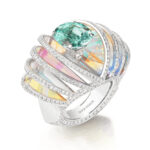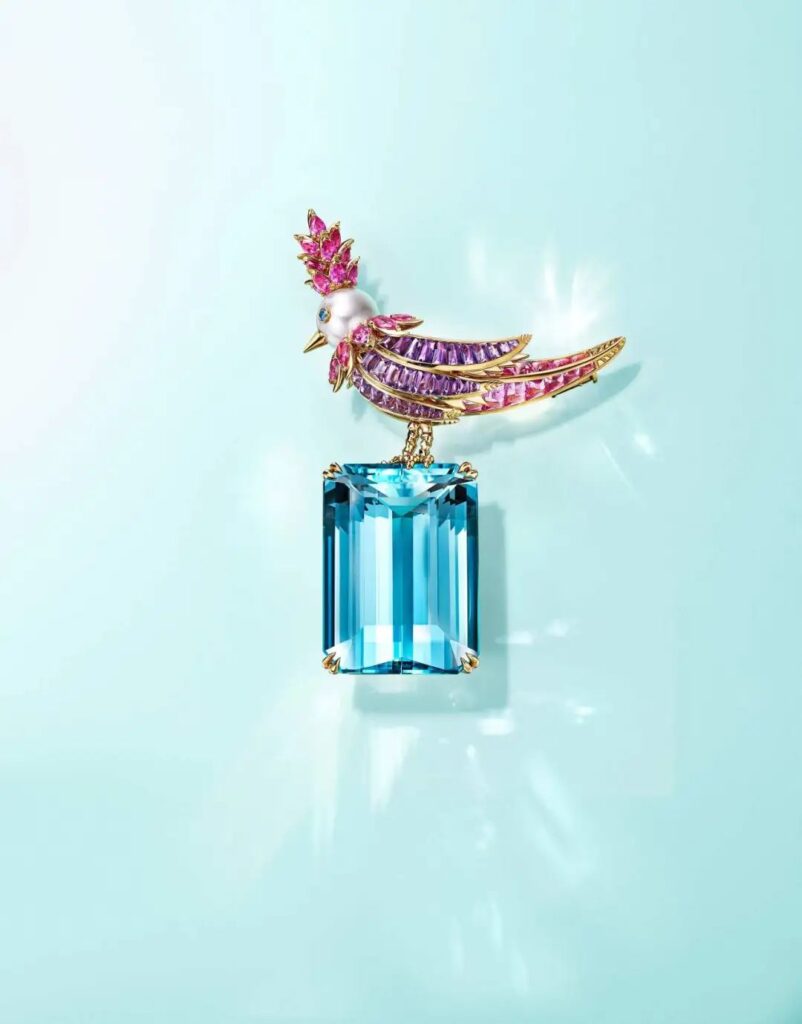
Aquamarine, the birthstone for March, has been a hot commodity in the high jewelry circle in recent years. Its clean, fresh blue color has made it a favorite gemstone among many luxury jewelry brands, and its availability in large sizes has easily secured its place as a popular choice for center stones. But from a collector’s perspective, would you invest in aquamarine?
Let’s examine aquamarine from several angles to determine if it’s worth acquiring. When comparing blue gemstones, the rarest and most expensive is undoubtedly the blue diamond, followed by sapphire from the “classic three gems.” But how do we rank the remaining blue semi-precious stones?
Indeed, there are many blue gemstones. In terms of rarity, Paraiba tourmaline and cobalt spinel might have a slight edge, but aquamarine certainly ranks among the top in value among semi-precious stones.
This is especially true for top-grade “Santa Maria” aquamarine, which specifically refers to aquamarines with medium to deep saturated bright blue color, without brown, yellow, or gray tones. Of course, it must also maintain high clarity.
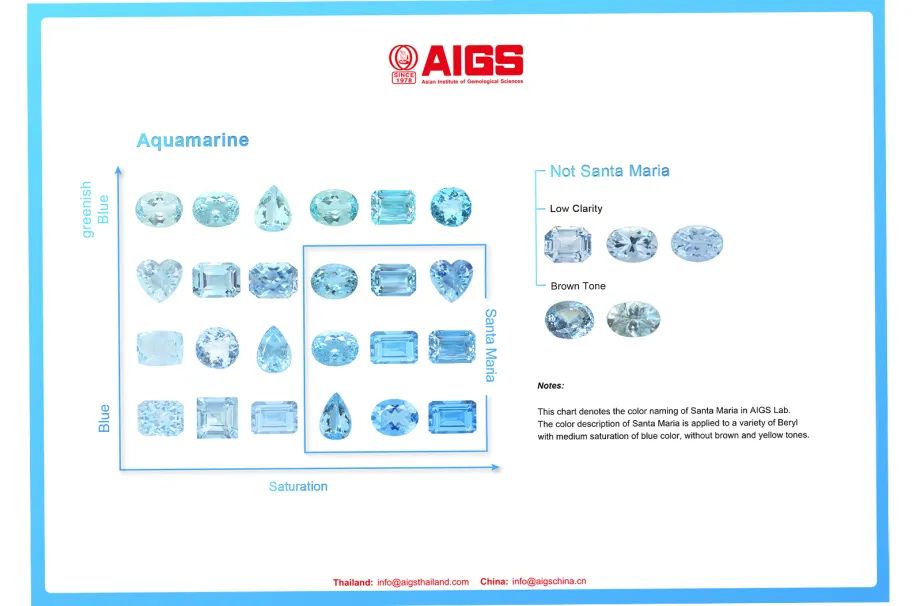
The term “Santa Maria” originates from the high-quality aquamarines produced in the Santa Maria de Itabira mine in Brazil. Although this mine is now depleted, the market still pursues this unique blue hue. As a result, many gemstone certification institutions have established grading systems or proprietary commercial names for this color.
For instance, AIGS created the “Santa Maria” color code, which evaluates based on color (hue, saturation, and clarity).
The Guild, on the other hand, divides aquamarine colors into four grades, with “Santa Maria Color” used to describe the highest quality aquamarine color. However, these classifications are based solely on color and not geographical origin.
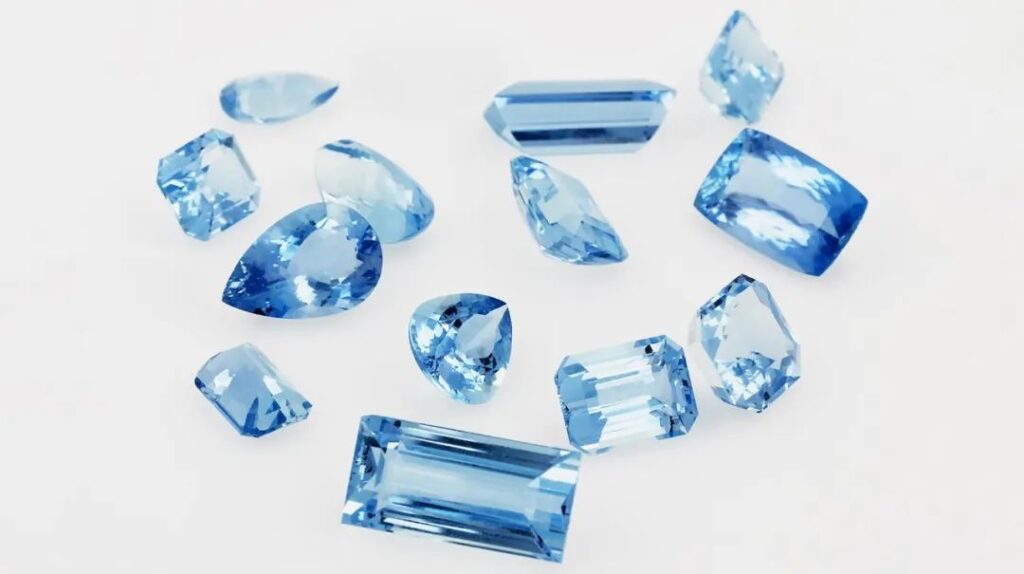
From AIGS Asian Institute of Gemological Sciences
The blue tone of aquamarine is incredibly fresh, reminiscent of the clearest seawater, representing a very pure blue.
You may have noticed that the most sought-after gemstones in the jewelry world often possess pure colors. In other words, when viewed on a color spectrum, their hue, saturation, and brightness are at their purest positions.
For example, the green of emerald, the red of ruby, and the blue of sapphire – the “classic three gems” – actually correspond to the most basic red, green, and blue (RGB) primary colors, which form the most fundamental color combination.
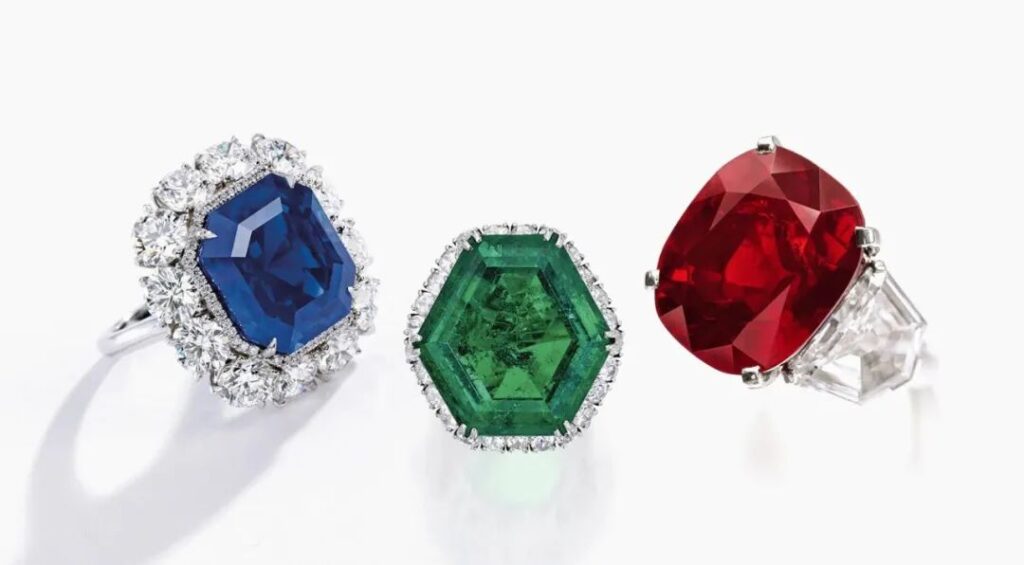
Why have people loved the “classic three gems” since ancient times? It’s not just because of their rarity, but also because in less industrialized eras, it was difficult to obtain these three pure colors.
For example, red represented reverence and authority in both Eastern and Western cultures because true red was extremely difficult to dye and fix. This made the “classic three gems,” which never risked fading, highly coveted by the nobility.
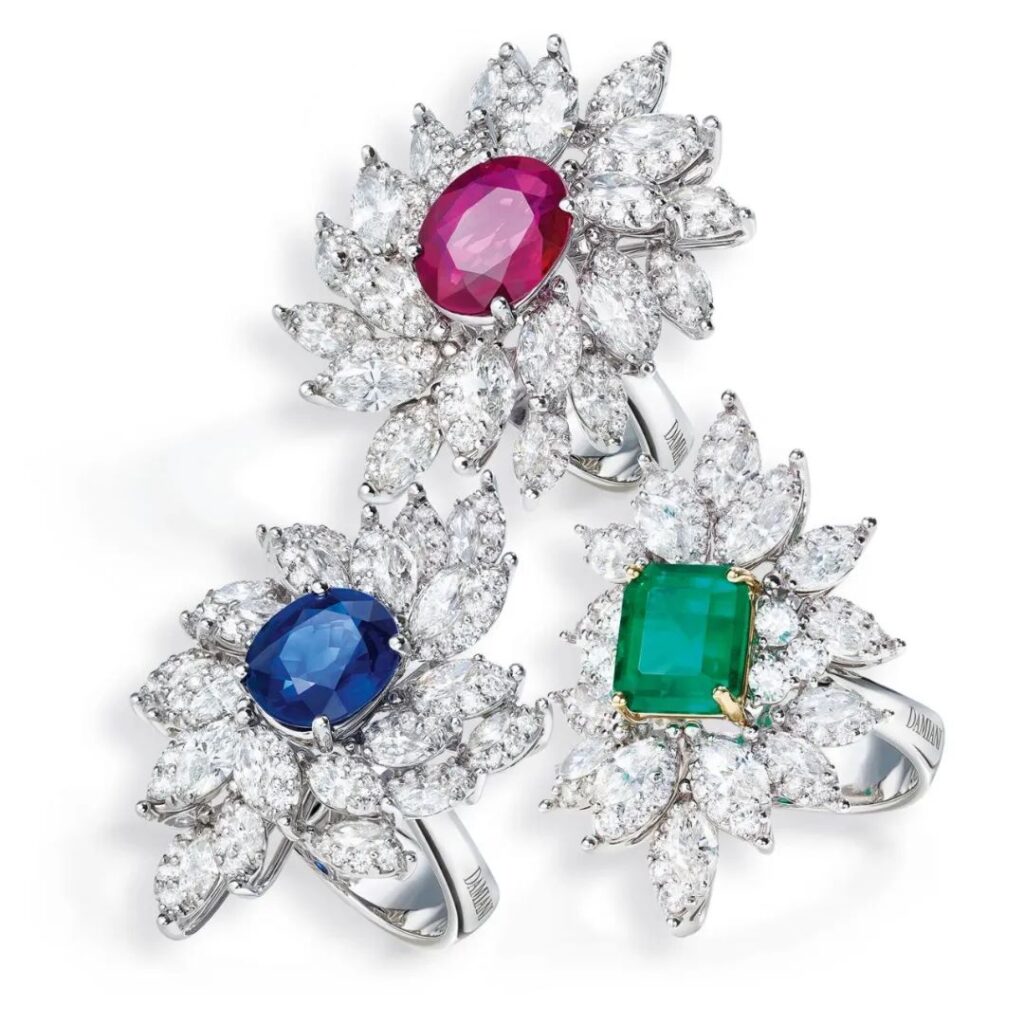
Ruby, sapphire, emerald, and diamond
Everyone knows that when buying colored gemstones, color is always the primary consideration. It largely determines the value of the gem. Why are “Jedi” spinel and “cobalt spinel” so sought after? It’s because their fluorescent colors appear more pure and vibrant.
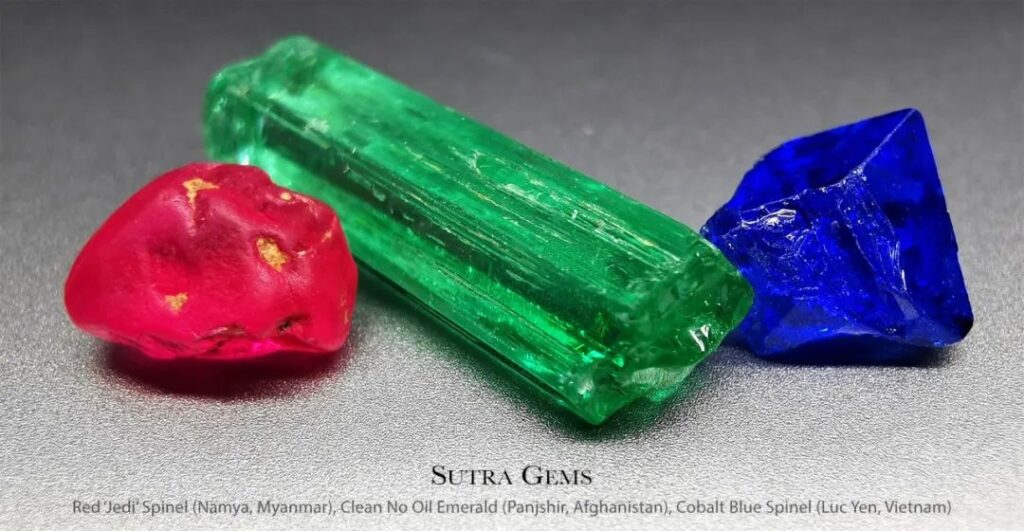
From Sutra Gems
Now you can understand why aquamarine commands such a high price. It perfectly matches a pure light blue, which is the overlap between green and blue in the primary colors.
Among all blue gemstones, only aquamarine, Paraiba tourmaline, and blue topaz fall within this color range. However, aquamarine’s blue tone is more refined than blue topaz and more elegant than the electric blue of dazzling Paraiba tourmaline.
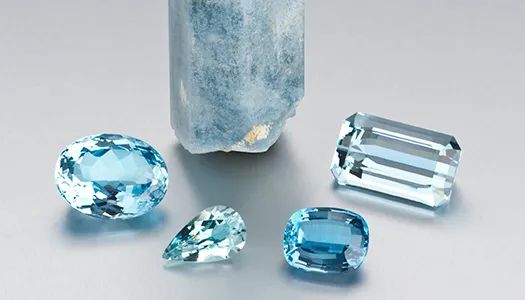
From GIA
Of course, aquamarine also has advantages in carat weight and clarity. It’s a “high-quality player” that easily produces large carat and high clarity gemstones.
It was first used as an amulet, with priests from ancient Rome to ancient Egypt using carved aquamarines in their rituals. However, its use as jewelry can be traced back to the Georgian period.
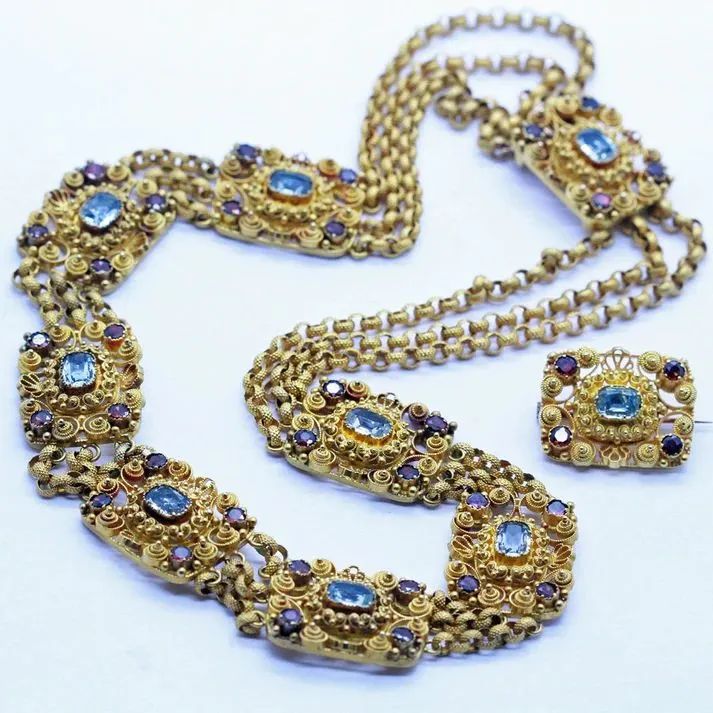
1820-1830
The Georgian and Victorian eras saw an influx of various semi-precious stones, but people still preferred darker gems like amethyst and garnet, with aquamarine mostly appearing in supporting roles. In the Edwardian era, jewelry trends shifted towards light and airy designs, with white jewelry made of platinum, diamonds, and pearls becoming mainstream. Some semi-precious stones with elegant colors began to emerge, and this is when aquamarine started to take center stage in jewelry.

Gold, garnet, aquamarine
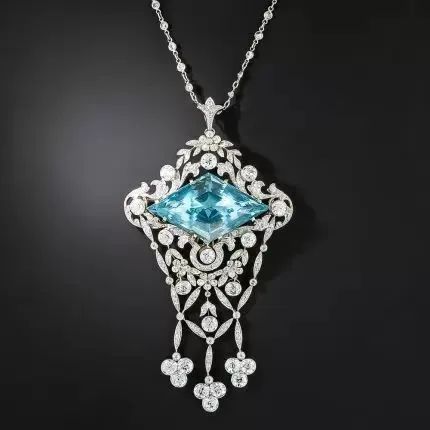
However, aquamarine’s true rise to fame in the jewelry world came in the 1940s, when gem supplies were abundant and many high-quality, large-sized aquamarines entered the market. Many jewelers set aquamarines in cocktail rings. From its “therapeutic effect” of helping people stay sober to its glamorous large face, it perfectly suited the needs of this popular jewelry style.
The main characteristic of Retro Style jewelry is oversized designs, which required large carat gemstones. Aquamarine appeared in many jewelry designs, often taking the center stage.
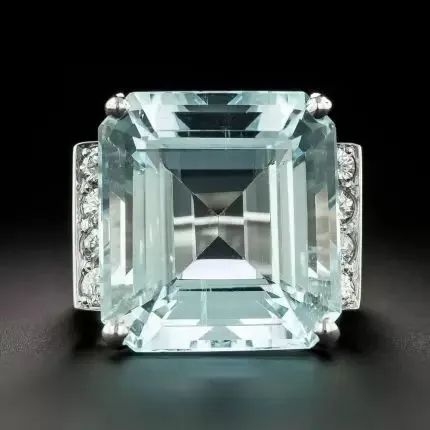
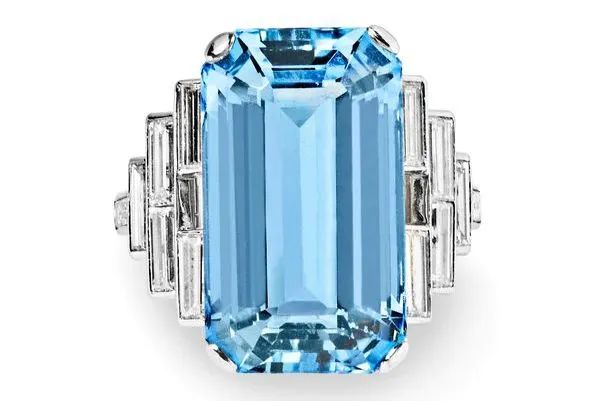
The subsequent popularity of aquamarine owes much to Princess Diana. She replaced her sapphire engagement ring with an aquamarine cocktail ring symbolizing independence. The Asprey ring, set with an aquamarine over 30 carats, ignited people’s passion for the gemstone.
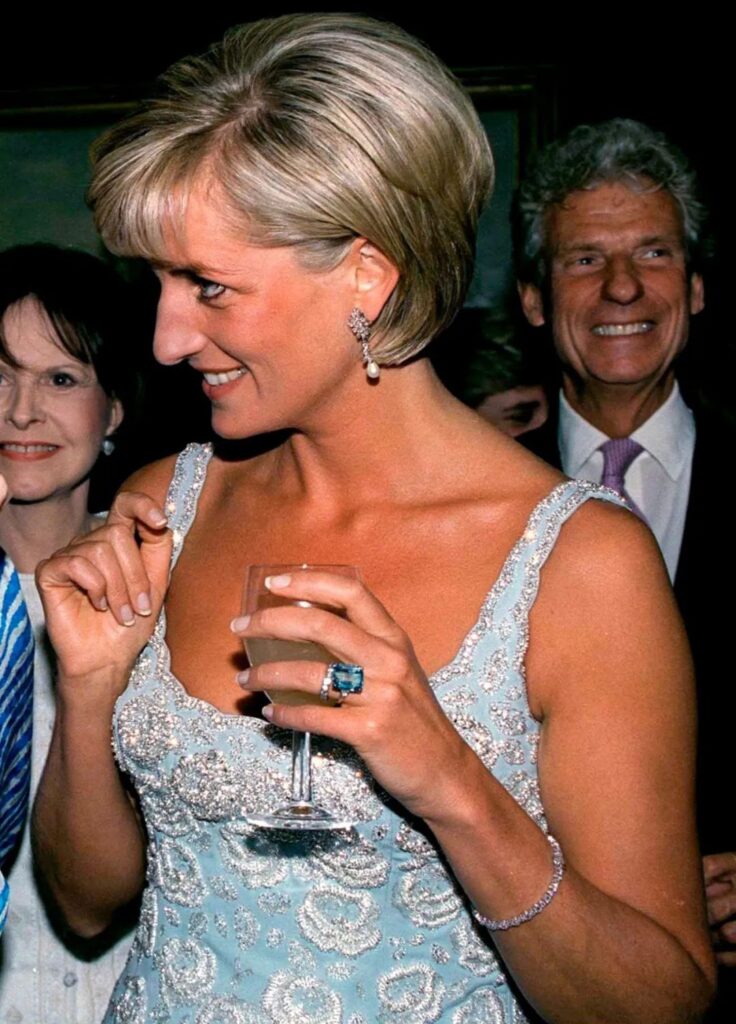
Asprey, the ancient British royal jeweler, also launched numerous aquamarine jewelry pieces in the 1990s, including the classic Daisy series featuring aquamarine as the center stone. Indeed, this fresh blue gemstone perfectly captures the artistic and fresh qualities of a daisy.

Entering the 21st century, aquamarine has become widely popular, emerging as a favorite in the high jewelry circle. Its versatility allows it to be both a star and a supporting player. With its unique color, large carat sizes, and high clarity, it’s truly adaptable. Whenever designers want to express themes related to the ocean, clear skies, summer, freshness, or youth, aquamarine is often their first choice.
For instance, Piaget’s 2023 “Metaphoria” high jewelry collection themed around ocean, streams, and ice crystals, chose sapphires, diamonds, pearls, and aquamarines to depict the shimmering waves of winding waters. The clear aquamarines perfectly describe the shallow, lively streams and curling waves.
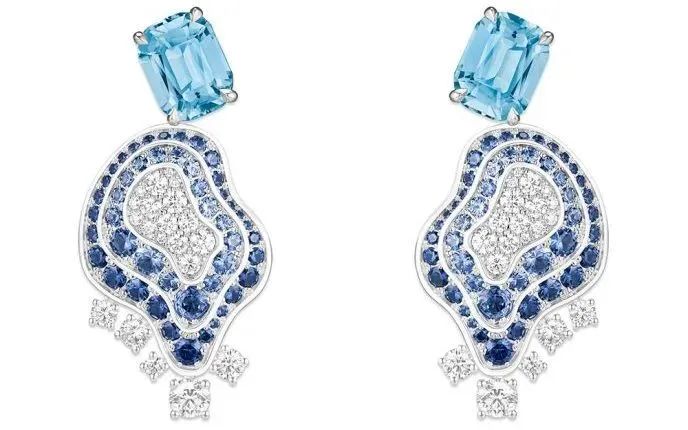
Metaphoria High Jewelry Collection
Aqua Summa Earrings
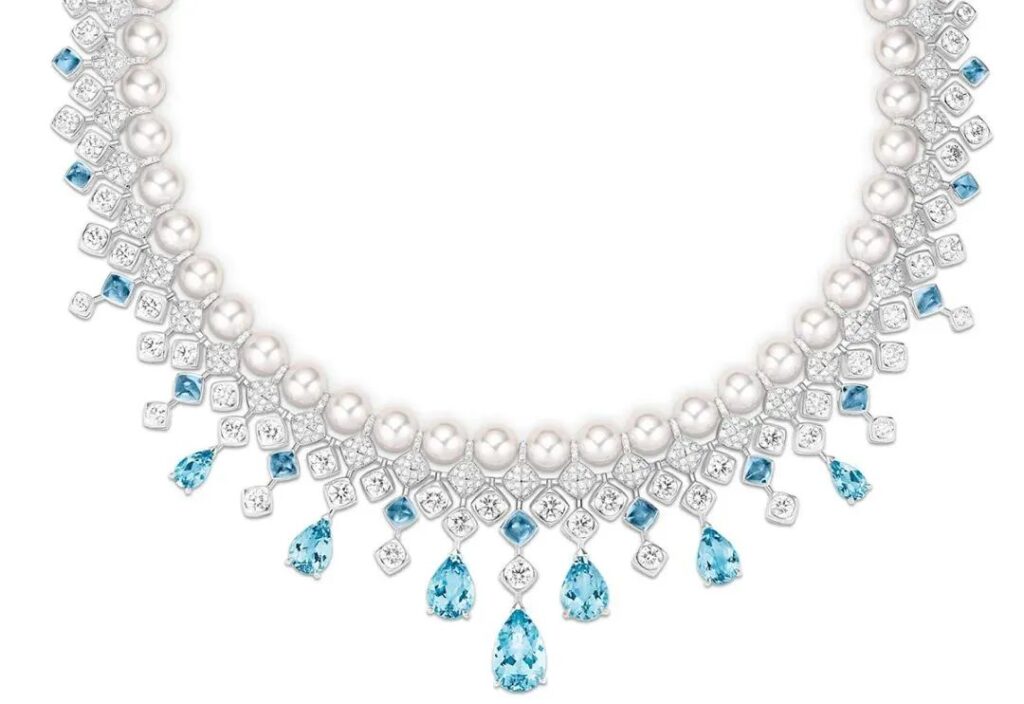
Metaphoria High Jewelry Collection
Aqua Necklace
Piaget wasn’t the only brand choosing aquamarine for their 2023 summer high jewelry collections. Bulgari, known for its masterful use of color, based its collection on the “Mediterranean” theme. Naturally, pieces depicting ocean scenery were abundant, with many impressive designs featuring aquamarine as the main stone.
The Muse necklace, which combines aquamarine and sapphire, is particularly striking, allowing one to directly feel the gentleness and coolness of ocean waves.
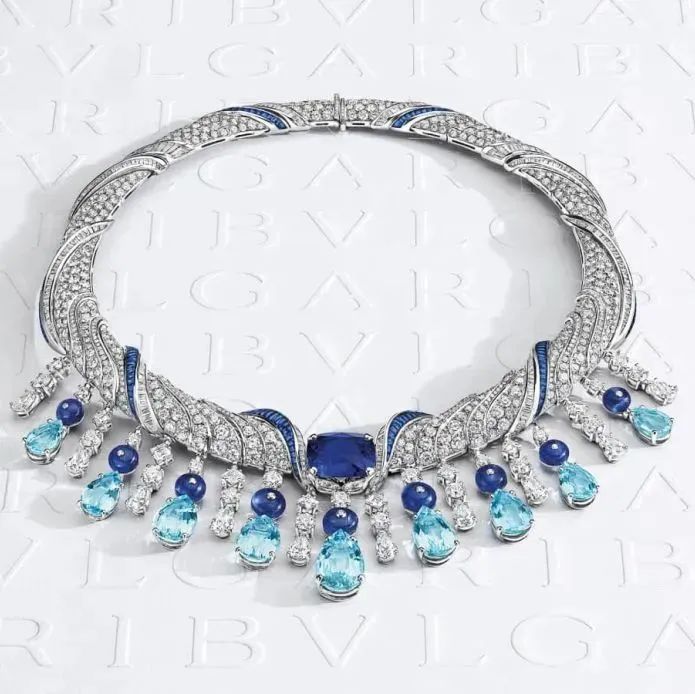
Mediterranean High Jewelry Collection
Muse Necklace
Cartier’s Le Voyage Recommencé high jewelry collection also features aquamarine prominently. Although the series is themed around architecture and Islamic art, the “regular feature” panther still follows naturalism. This season’s Panthère Givrée necklace chose clear aquamarines as the main stones, with a diamond and onyx panther guarding three aquamarines totaling 20.33 carats.
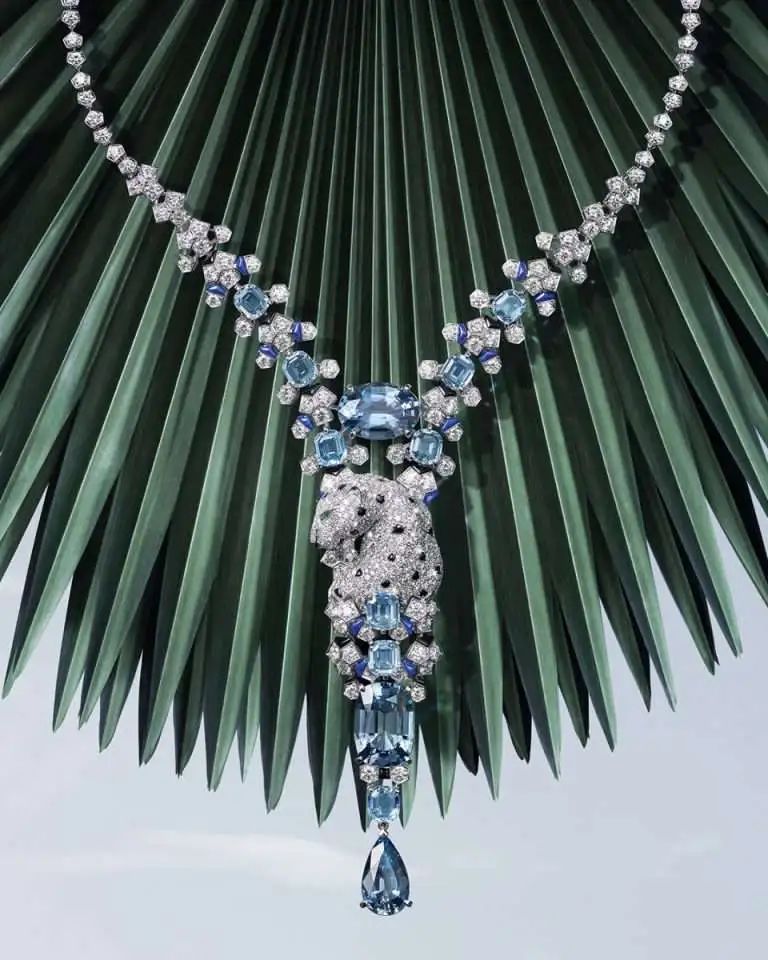
Le Voyage Recommencé High Jewelry Collection
Panthère Givrée Necklace
Of course, the most impressive use of aquamarine comes from Tiffany & Co. Last year’s Blue Book high jewelry collection was themed “Out of Blue,” entirely dedicated to praising the ocean, with aquamarine naturally taking center stage.

Blue Book High Jewelry Collection
Out of the Blue Chapter Necklace
Opal, aquamarine, beryl, tourmaline, diamond
Even more eye-catching are the “Bird on a Rock” series pieces released from the end of last year to the beginning of this year. This classic design, introduced by Jean Schlumberger in 1965, is considered Tiffany’s “signature design.” Over the years, versions replacing the “Rock” with various large carat gemstones have been numerous.
However, starting last year, Tiffany began adding more variations to this series. It began by replacing the traditional large carat gemstones with rare natural pearls. Subsequently, it expanded beyond brooch designs, introducing a wider variety of style combinations.
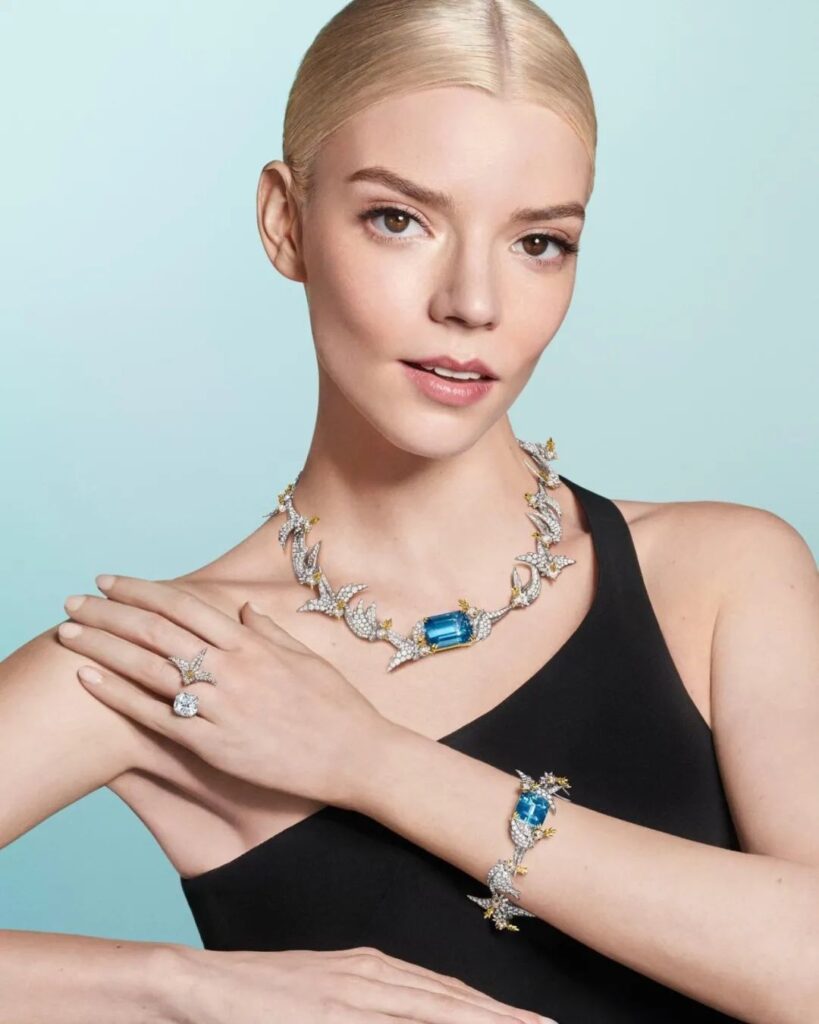
Blue Book High Jewelry Collection
Out of the Blue Chapter
Bird on a Rock Necklace and Bracelet
18K platinum, yellow gold, aquamarine, diamonds
In March this year, Tiffany launched the new Rainbow Bird on a Rock brooch. This new piece cleverly combines colored gemstones, brilliant diamonds, and lustrous pearls, decorated with the complex technique of metal foil inlaid enamel. This gives the bird more variations while retaining Jean Schlumberger’s signature woven gold and love for enamel.
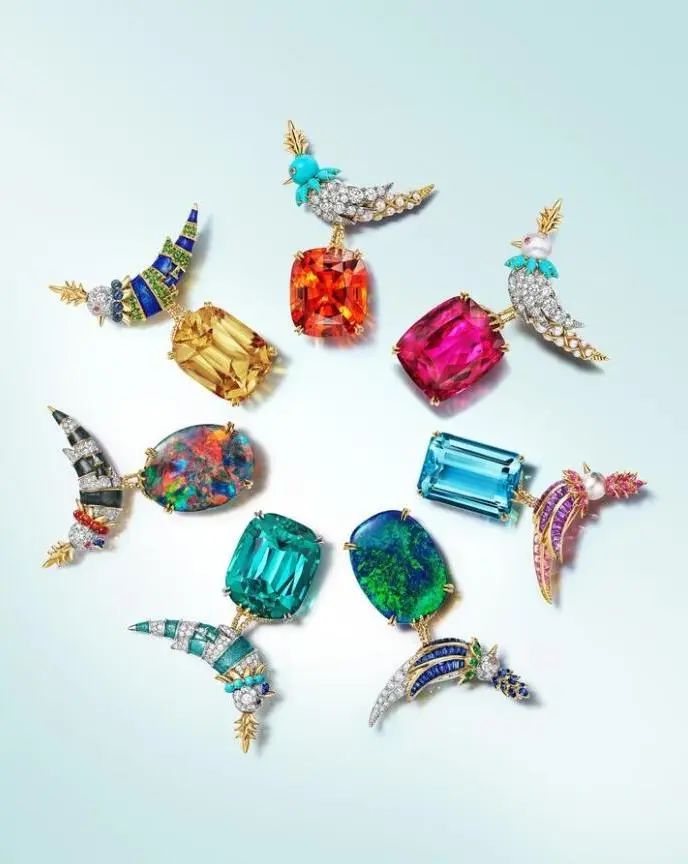
Rainbow Bird on a Rock Brooch
Our editor-in-chief Jing was invited to Shanghai to appreciate the new works up close. She shared with her colleagues that the pieces she most wanted to acquire were those with black opal and aquamarine as the main stones.
Particularly the aquamarine piece, which features a round pearl as the bird’s adorable head, pink sapphires and amethysts set in distinct layers for the wings, outlined with gold. It stands on a 41-carat aquamarine, with an overall color scheme that’s lively and youthful yet elegant, with rich and delicate texture variations that aren’t chaotic. From color matching to design, it’s utterly captivating.
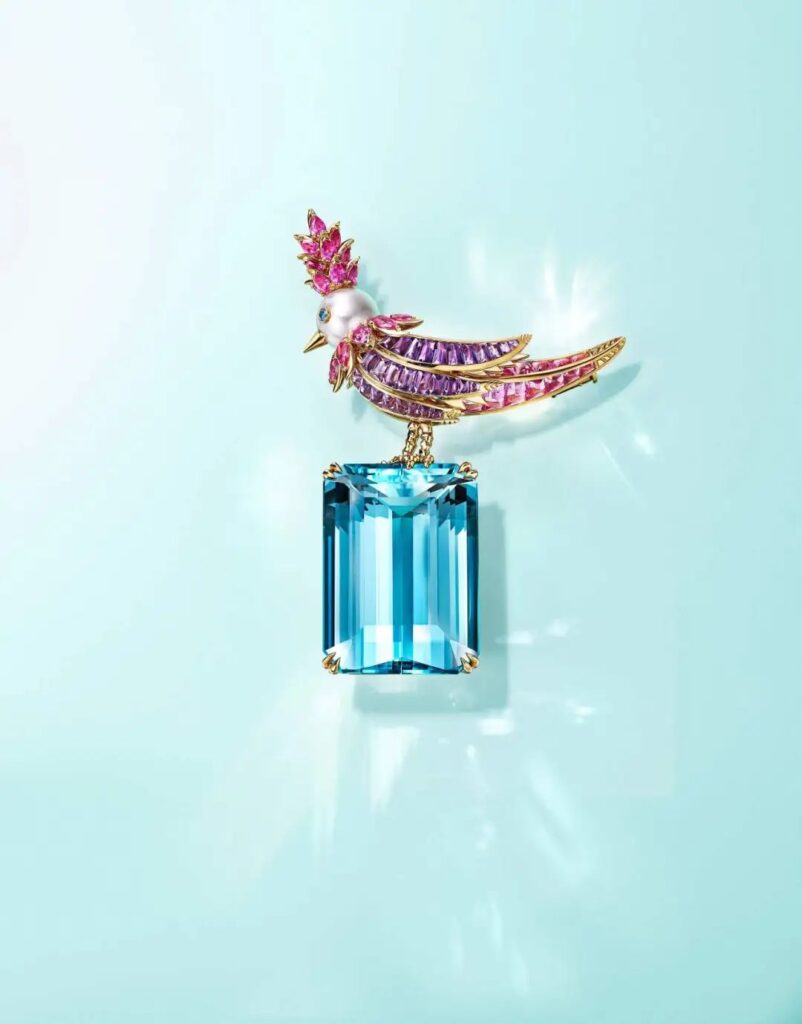
Rainbow Bird on a Rock Brooch
Platinum, yellow gold, aquamarine, pearl, sapphire, amethyst
You can see the excellent performance of aquamarine in luxury jewelry brands, right? They excel at making gemstones echo each other, achieving balanced and harmonious creative themes. As the main stone, aquamarine always manages to highlight its refreshing blue color, making you feel as if a cool breeze is passing over water, involuntarily calming you down to enjoy that serene feeling.
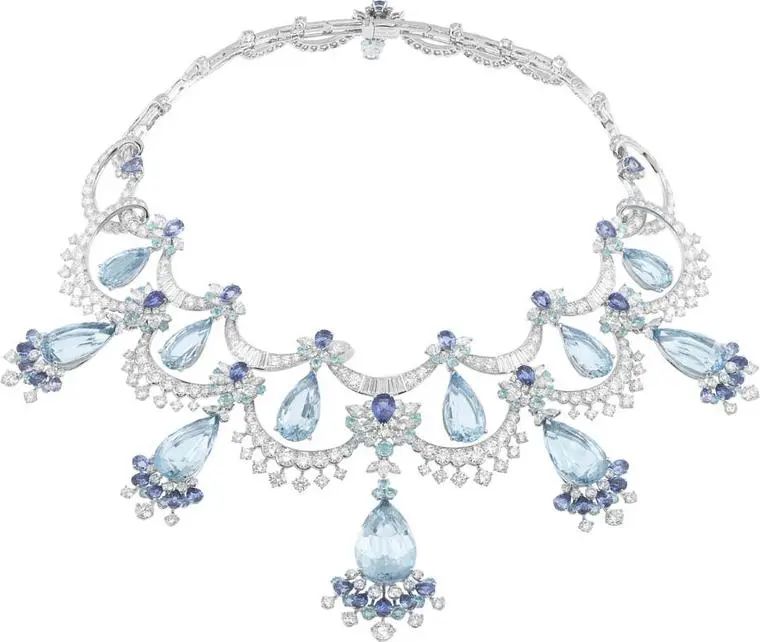
Peau d’ane High Jewelry Collection
Color of Time Dress Necklace
Diamonds, tourmaline, sapphires, and 12 pear-shaped aquamarines, totaling 129.87 carats
For independent designers, aquamarine in their hands more often showcases the charm of the gemstone itself. Although styles vary, you’re undoubtedly first attracted by the aquamarine itself, then notice the entire piece.
For example, Seijo’s aquamarine pendant: although the designer has done a lot of work around this teardrop-shaped aquamarine, setting wave lines with colored gemstones above it, when you see it, you still first notice the clear blue of the aquamarine.
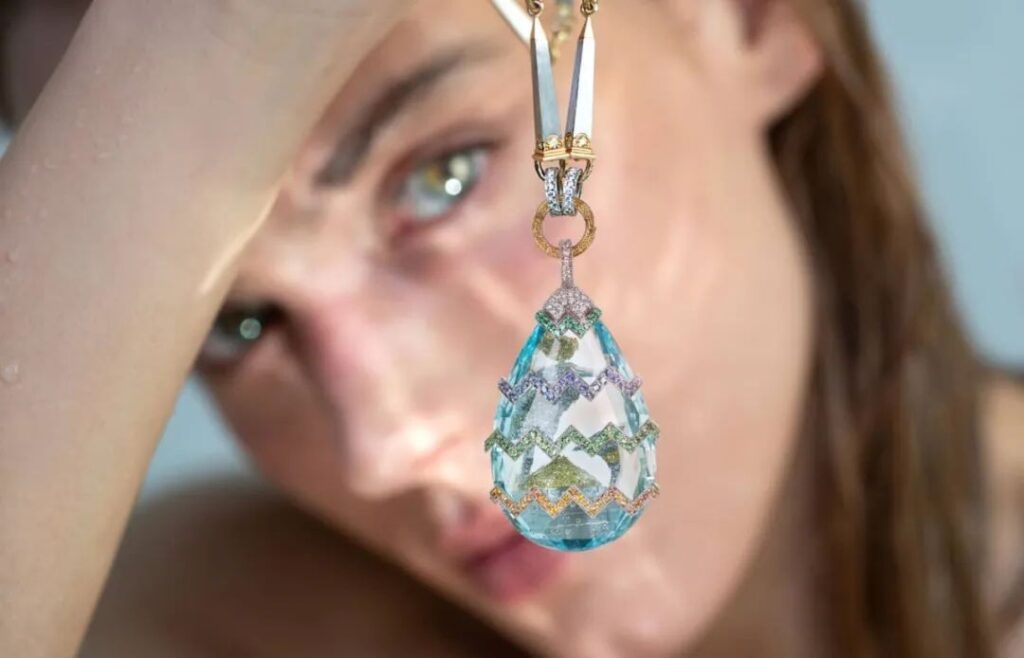
Fabio Salini consistently follows an abstract path. Against the backdrop of steady carbon material and white gold diamonds, the high-clarity aquamarine can freely display its boundless blue.
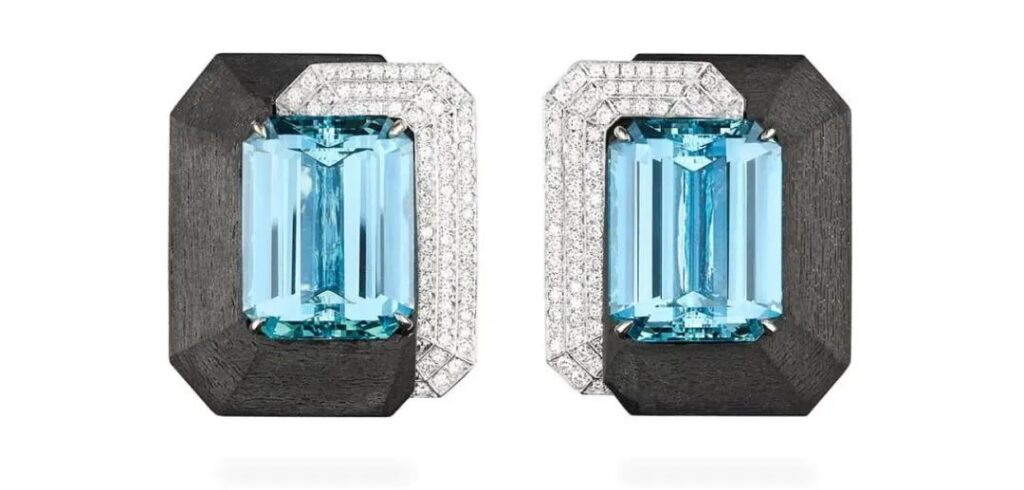
Remember Emily P. Wheeler? We’ve introduced this young designer in our rainbow jewelry feature. Her designs are avant-garde and focus on highlighting the color of gemstones. She likes to use color as a theme and is willing to create jewelry for women who aren’t afraid to break norms and dare to go beyond conventions.
So you can see in her aquamarine jewelry designs, large carat aquamarines boldly set in straightforward lines. Who can ignore such vibrant designs?

Some designers don’t care about the high clarity of aquamarine but are more obsessed with its unique light blue color. For instance, the aquamarine ring brought by Italian designer Francis de Lara chose a cabochon aquamarine. Doesn’t it look like viewing the gemstone through seawater, with that blue tone dancing under the sunlight refracted through the water?

Another Italian jewelry designer, Alessio Boschi, created a dolphin ring with a vintage choice of carved aquamarine. Yes, aquamarine is very suitable for carving. The master set a three-dimensional dolphin shape with diamonds and gemstones at the bottom of the ring. However, what truly attracts people is the dolphin carved from aquamarine on the ring face. That ancient, subtle dolphin seems to contain a spirit truly swimming in shallow seas.
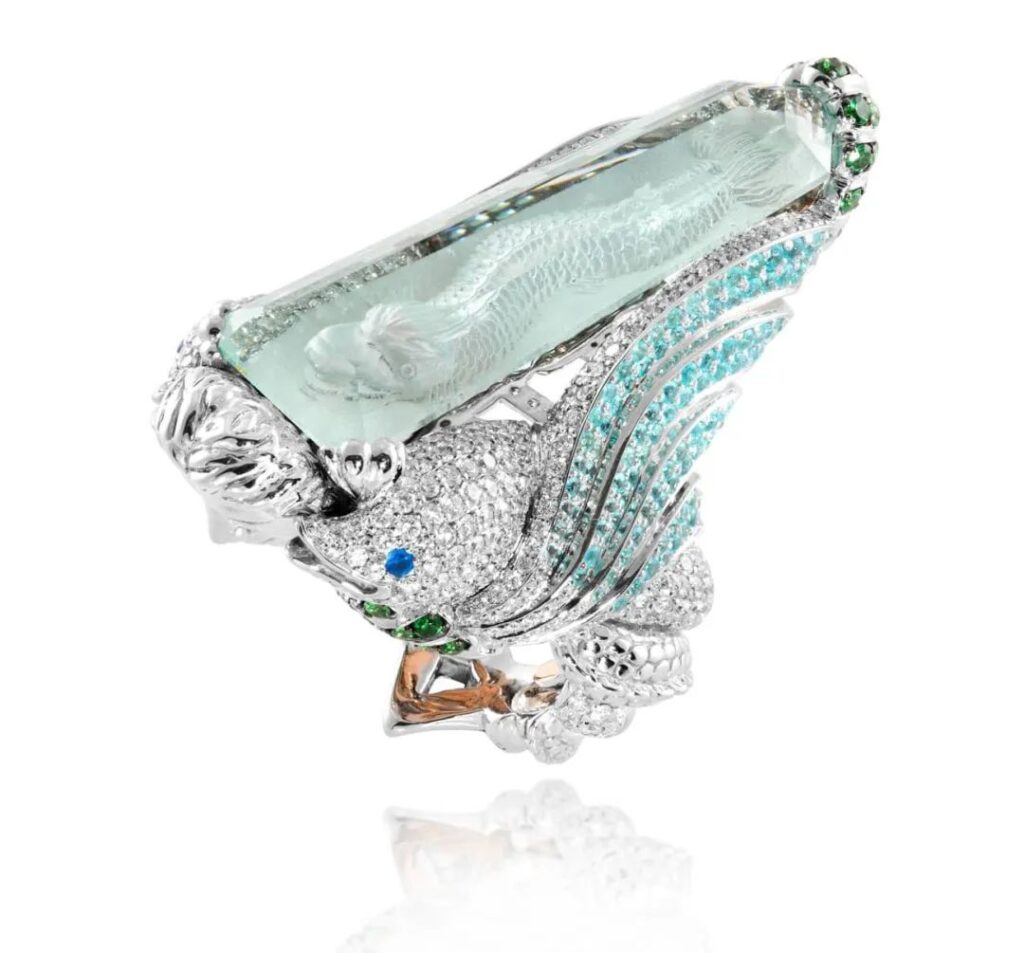
By now, you’re probably enchanted by this March birthstone. But let’s return to our initial question: is it worth acquiring for your collection?
According to gem dealer Richard Drucker’s recent report in the book “Constantin Wild: Gems, Colours & Wild Stories,” aquamarine prices have been on an upward trend for the past 30 years. The increase has slowed in recent years, with prices for most well-cut light blue aquamarines remaining stable. However, prices for particularly high-quality aquamarines continue to rise, with “Santa Maria” aquamarines nearly doubling in price over the past two years.

Eric Braunwart, founder of Columbia Gem House, states that there’s growing interest in soft-toned gemstones, with many people beginning to accept aquamarine’s light blue hue.
He says, “Currently, there’s an ample supply of high-quality aquamarines, from small to extra-large sizes, meeting all design needs. However, the greatest increase in demand is for stones between 2 and 15 carats. The main markets for aquamarine are Brazil, the United States, Canada, and Europe.
Smaller, finer stones are sold to Japan, and demand in the Far East seems to be growing as they become more familiar with gemstones beyond diamonds, jade, rubies, and emeralds.”

Catherine Tiara
So, aquamarine has some potential for value preservation and appreciation, but it’s not at its peak growth rate now. Ladies can consider acquiring some. So, what kind of aquamarine should you choose?
For those purely interested in gem collection, the advice is always “Santa Maria” aquamarine. High-quality, rare gems are always the first choice for collection, as the value of scarce resources remains stable regardless of market changes.
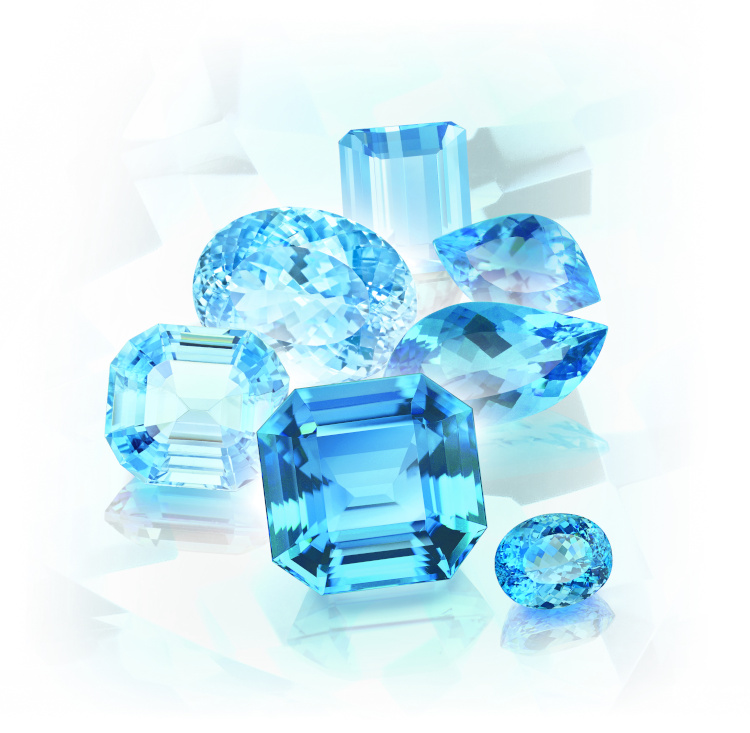
But for those who simply love aquamarine’s clean and youthful blue tone that brings a sense of tranquility, perhaps choosing an aquamarine that truly touches your heart and having it made into jewelry that you can wear and see every day is the best choice.
Aquamarine has an advantage that other gemstones don’t: its per-carat price doesn’t increase dramatically with carat weight. Compared to emerald, for example, both belong to the beryl family and can easily produce large carats. However, emerald crystals are small and it’s difficult to find flawless ones, so the price of emerald increases exponentially with carat weight.

20K yellow gold, aquamarine, opal, diamonds
Aquamarine, on the other hand, naturally tends to have high clarity. The per-carat price of a 1.5-carat aquamarine is roughly the same as a 0.3-carat one, giving us the opportunity to purchase large carat aquamarines.
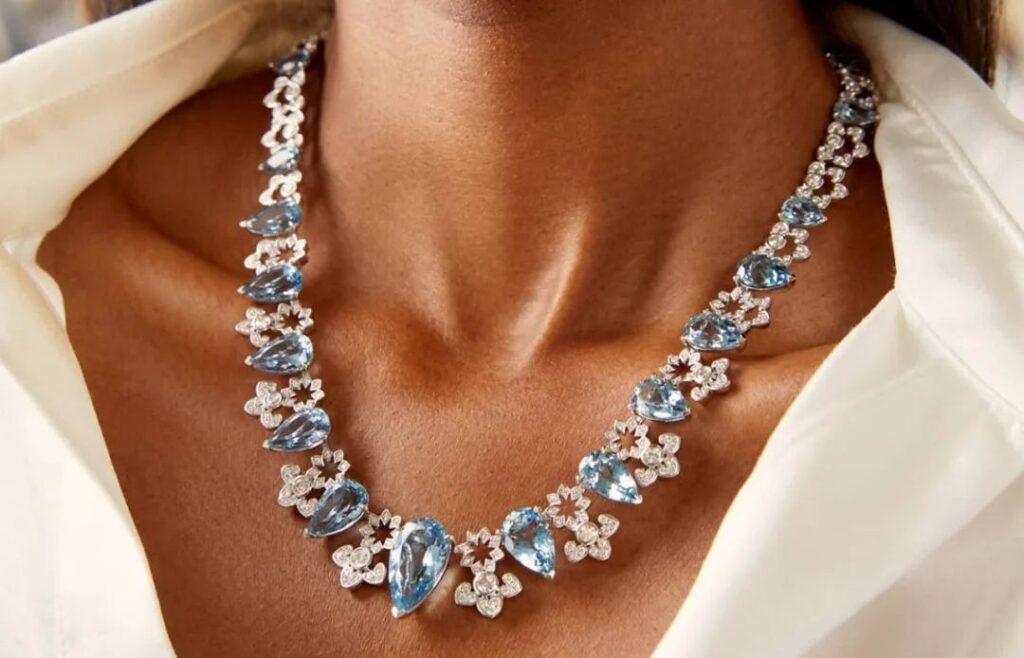
Furthermore, with a hardness of 7.5 to 8, aquamarine is a favorite among gem cutters as it allows them to experiment with various innovative cuts. While round brilliant, emerald, and cabochon cuts remain the most popular, it offers many more possibilities. Faceted, non-faceted, or even carved aquamarine can all give you a soft, serene blue, meaning you have more choices when selecting aquamarine jewelry.

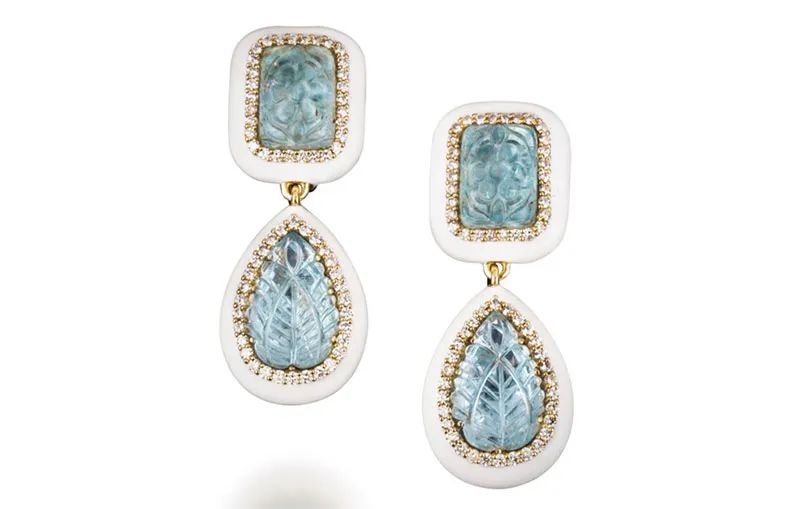
Gold, carved aquamarine, enamel, diamonds
Have you made up your mind? Hurry and get an aquamarine! Summer is not far away, and who wouldn’t want a clear and serene gemstone to accompany them through the long, hot summer days?
“Santa Maria” Prices Soaring? How Much More Potential Does the High Jewelry Darling Aquamarine Have?
Tweet
